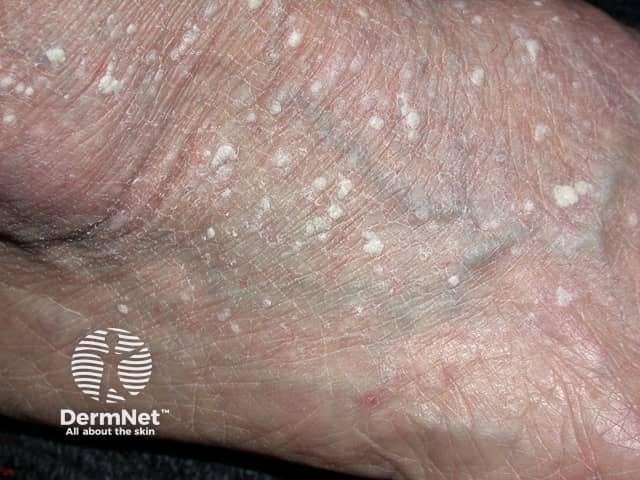Main menu
Common skin conditions

NEWS
Join DermNet PRO
Read more
Quick links
Author(s): Neakiry Kivi, University of Otago, New Zealand (2023)
Reviewing dermatologist: Dr Ian Coulson
Edited by the DermNet content department
Introduction
Demographics
Causes
Clinical features
Variation in skin types
Complications
Diagnosis
Differential diagnoses
Treatment
Prevention
Outcome
Stucco keratosis is a type of benign, papular skin lesion that has a characteristic ‘stuck on’ appearance and commonly affects the distal limbs of elderly men.
These lesions represent acquired, focal abnormalities of skin keratinisation.
Stucco keratosis may also be referred to as keratosis alba, or less commonly, keratoelastoidosis verrucosa or verruca dorsi manus et pedis.

Florid lesions of stucco keratoses on the ankle
Stucco keratosis most commonly occurs in fair-skinned individuals older than 40 years old, with peak incidence from ages 40–60. It is estimated that males are four times as likely to be affected compared to females.
Reported prevalence ranges from 7–20%. This may be an underestimate given that stucco keratoses are often inconspicuous and asymptomatic.
The cause of stucco keratosis is largely unknown.
Many people affected may have a history of chronic sun exposure. However, the relationship of this to the development of stucco keratosis is uncertain and difficult to quantify as lesions are not always found in sun-exposed areas of skin.
Stucco keratosis may be associated with cutaneous and mucosal variants of human papillomavirus (HPV).
Having dry, ichthyotic skin may predispose individuals to develop stucco keratosis. Exposure to heat, chemicals, and tar may also contribute.
The clinical features of stucco keratoses include:
Stucco keratoses are commonly found symmetrically on the lower legs, ankles, and dorsum of the foot. Less common sites include the extensor aspect of the forearms, dorsal surface of the hands, and trunk. Palms of hands, soles of feet, and the head are not known to be affected.
The number of lesions can range from a few to several hundred.
A distinctive characteristic of stucco keratosis is that its scaly surface can be easily flicked off. Such mechanical removal leaves behind a dry, flat, and non-bleeding or exudative surface, level with the surrounding skin, and often with a remaining collarette of scale. However, the keratotic papule will usually reform over a few days.
Despite the term being used interchangeably with stucco keratosis, keratosis alba may represent a separate or related condition seen more commonly in darker skin types. A 1970s case series describes keratosis alba in dark skin as slightly elevated hypopigmented lesions with a cauliflower-like surface and less surface scale, that cannot be easily flicked off.
Aesthetic only — these lesions are not premalignant, not associated with systemic disease, and usually asymptomatic.
The diagnosis of stucco keratosis can be made clinically, or in combination with shave biopsy to exclude other diagnoses such as skin cancer.
Features under dermoscopy may include:
Histopathological features may include:
It is debated whether stucco keratosis is a subtype of seborrhoeic keratosis. Histologically, stucco keratoses are papillomatous keratoses which lack the horn cysts and basaloid cells seen in seborrheic keratoses. However, the two conditions share similar genetic mutations.
Differential diagnoses for stucco keratosis include:
No treatment is universally effective at eradicating stucco keratosis.
While the optimal therapeutic approach is debated, treatment strategies include:
However, recurrence is common.
There is limited evidence that topical imiquimod or maxacalcitol (vitamin D3) may be effective for permanent regression of stucco keratosis.
How to prevent stucco keratosis is unknown.
Lesions tend to persist or recur, but are benign and without malignant potential.